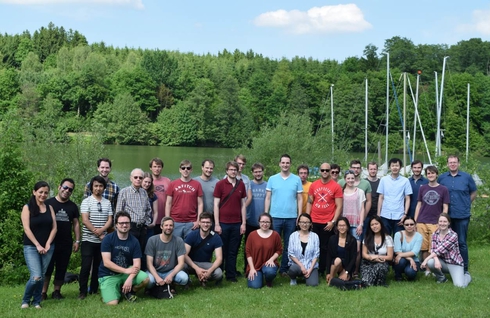Research
-
The Pattern Recognition Lab
The Pattern Recognition Lab (Computer Science 5) is part of the Department for Computer Sciences of the Friedrich-Alexander University of Erlangen-Nuremberg. Since its foundation in 1975 until Sep. 2005, Professor Dr.-Ing. Heinrich Niemann held the Chair; since Oct. 2005, Prof. Dr.-Ing. Joachim Hornegger was head of the chair. In April 2015, Prof. Dr.-Ing. Andreas Maier became head of the lab.
"Pattern Recognition" stands for the search of an automatic transformation from samples, obtained from the environment with suitable sensors, into a symbolic description which is specific to the application. An example of a pattern recognition system is a speech dialogue system: a user can ask by telephone a computer with natural speech. The microphone (the sensor) in the telephone samples the sound waves. With algorithms, developed at our chair, the system can analyze the natural speech to get the information which is required to generate an adequate answer and present the synthesized speech to the human user. Pattern recognition deals with all aspects of the whole procedure, from data acquisition to generation of an answer. Applications of pattern recognition range from industrial image processing, recognition of handwritings, medical image processing, speech dialogue systems, computer vision to problems of control engineering. The research at the Chair for Pattern Recognition is organized according to the following fields:
The main focus is on medical pattern recognition. In the following a short overview over the current research projects will be given.
Focus of research
- image processing
- mono- and multimodal image fusion and registration
- tomographic reconstruction
- segmentation and classification in medical image processing
- 3-D object recognition
- object tracking
- active sensor data processing
- 3-D reconstruction and camera calibration
- plenoptic modeling
- augmented reality
- autonomous mobile systems
- mimics and gestics
- speech processing
- prosody
- dialogue
- recognition of user states (angry, tired, hesitant, ...)
-
Annual reports
 jb lme 2015.pdf(Annual Report 2015)336 K
jb lme 2015.pdf(Annual Report 2015)336 K jb lme 2014.pdf(Annual Report 2014)374 K
jb lme 2014.pdf(Annual Report 2014)374 K jb lme 2013 01.pdf(Annual Report 2013)378 K
jb lme 2013 01.pdf(Annual Report 2013)378 K jb lme 2012 01.pdf(Annual Report 2012)366 K
jb lme 2012 01.pdf(Annual Report 2012)366 K jb lme 2011 01.pdf(Annual Report 2011)329 K
jb lme 2011 01.pdf(Annual Report 2011)329 K jb lme 2010 01.pdf(Annual Report 2010)307 K
jb lme 2010 01.pdf(Annual Report 2010)307 K jb lme 2009 01.pdf(Annual Report 2009)272 K
jb lme 2009 01.pdf(Annual Report 2009)272 K jb lme 2008 01.pdf(Annual Report 2008)221 K
jb lme 2008 01.pdf(Annual Report 2008)221 K jb lme 2006 2007 01.pdf(Annual Report 2006-2007)295 K
jb lme 2006 2007 01.pdf(Annual Report 2006-2007)295 K jb lme 2005 07.pdf(Annual Report 2005)1.1 M
jb lme 2005 07.pdf(Annual Report 2005)1.1 M jb lme 2004 07.pdf(Annual Report 2004)171 K
jb lme 2004 07.pdf(Annual Report 2004)171 K jb lme 2003 07.pdf(Annual Report 2003)736 K
jb lme 2003 07.pdf(Annual Report 2003)736 K jb lme 2002 07.pdf(Annual Report 2002)1.0 M
jb lme 2002 07.pdf(Annual Report 2002)1.0 M jb lme 2001 07.pdf(Annual Report 2001)605 K
jb lme 2001 07.pdf(Annual Report 2001)605 K jb lme 2000 07.pdf(Annual Report 2000)1.0 M
jb lme 2000 07.pdf(Annual Report 2000)1.0 M jb lme 1999 07.pdf(Annual Report 1999)1.0 M
jb lme 1999 07.pdf(Annual Report 1999)1.0 M


 +49-9131-85-27775
+49-9131-85-27775
 +49-9131-85-27270
+49-9131-85-27270

